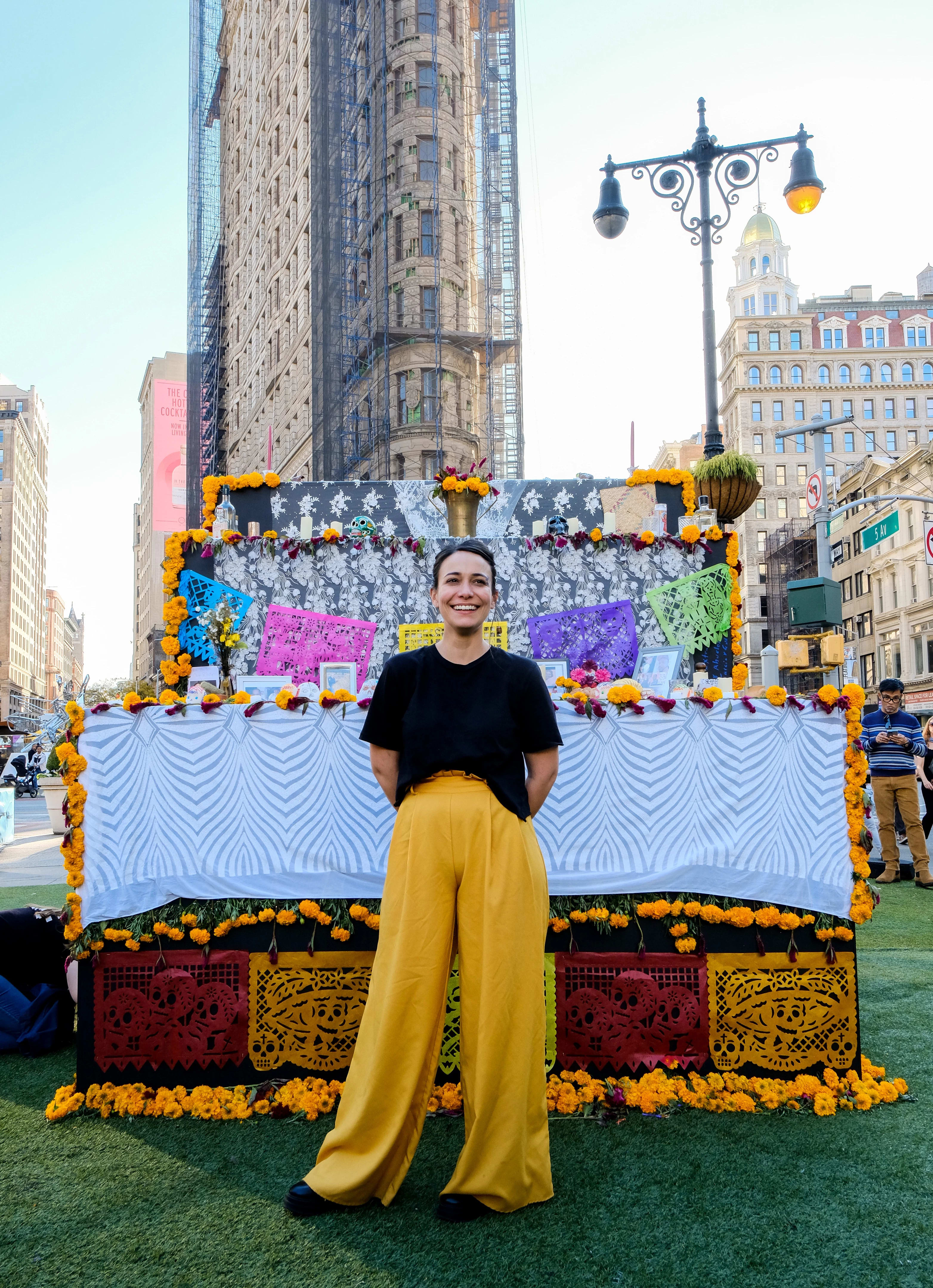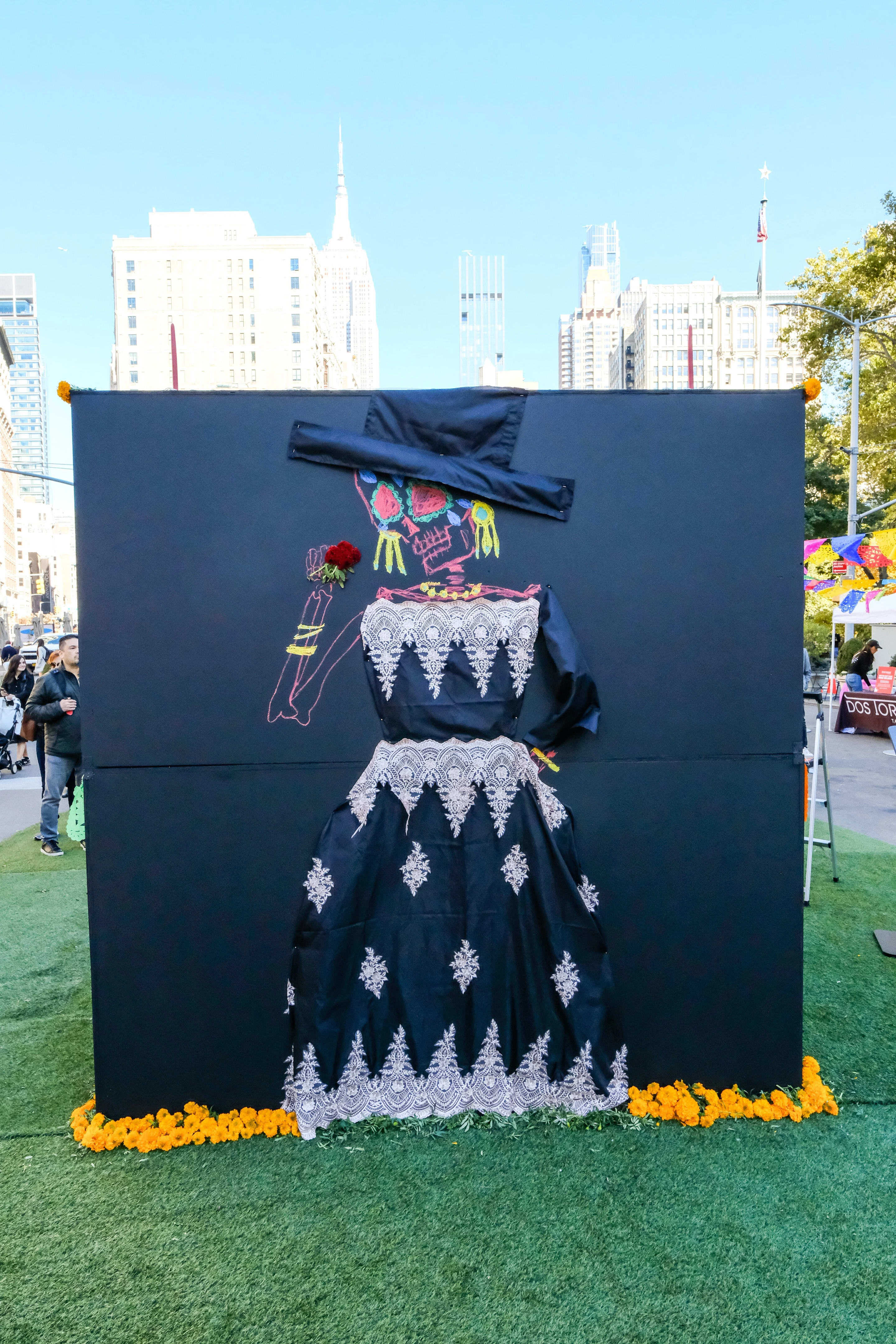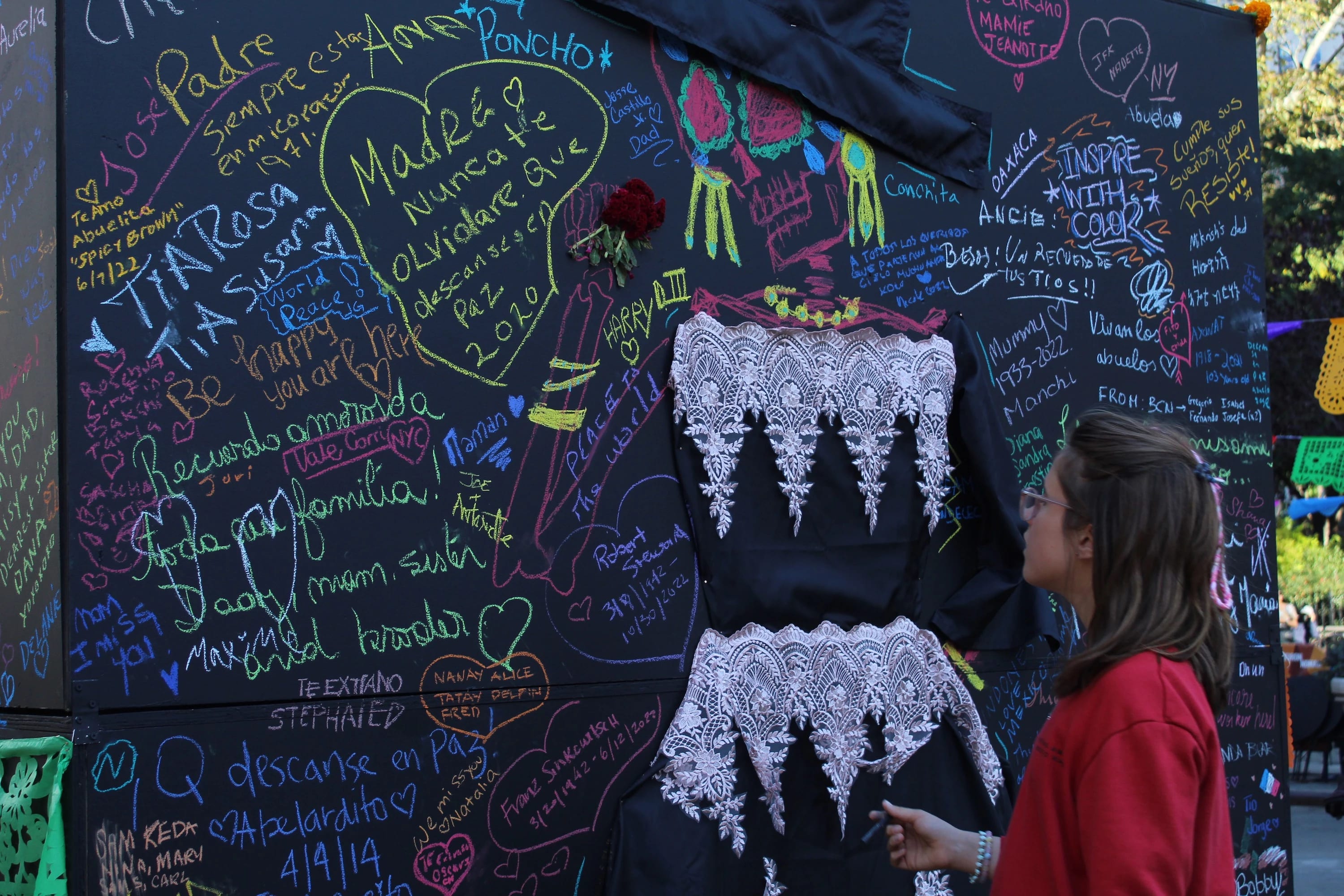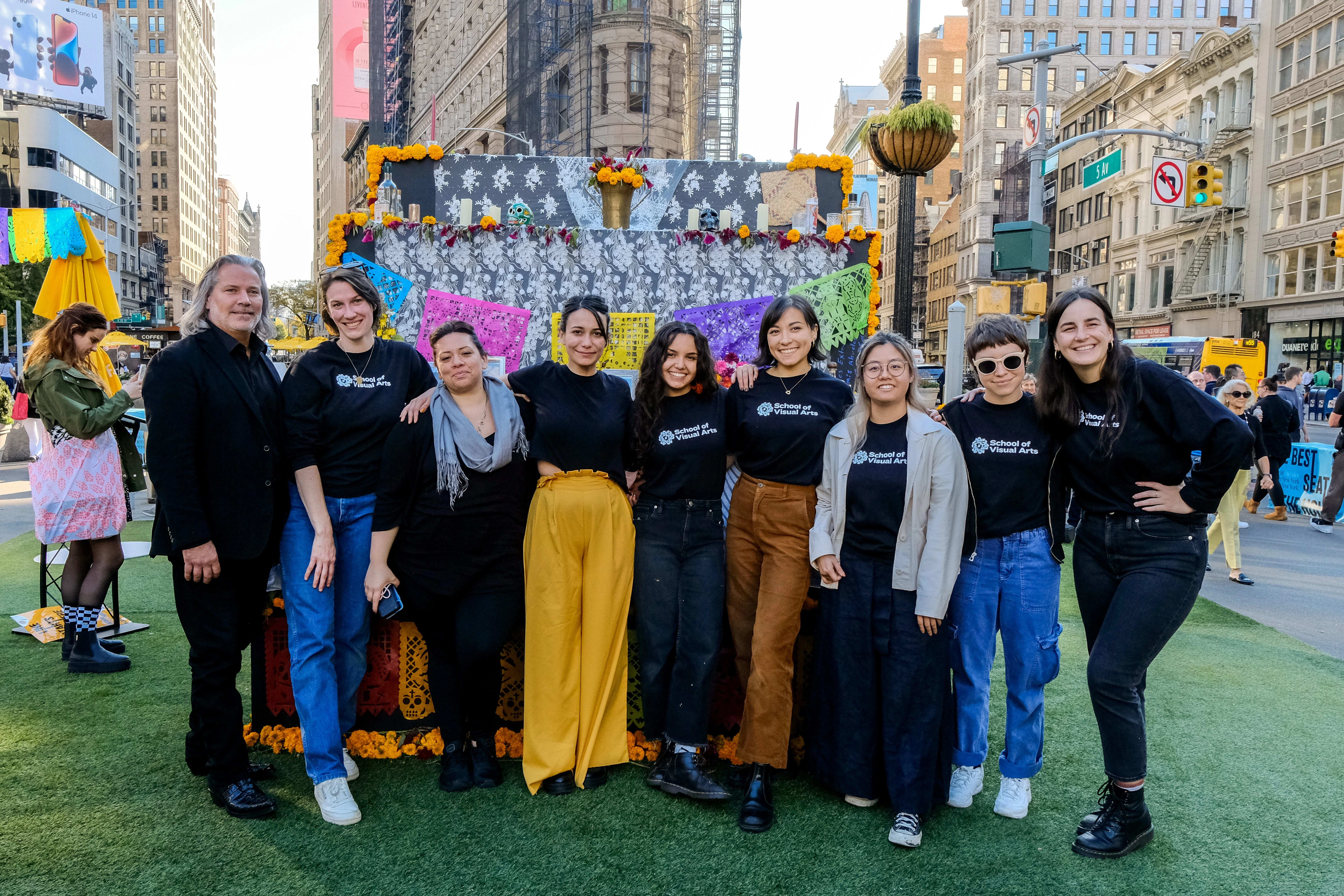Artist Feature

Artist Paulina Mendoza Valdez in front of the Dia de Muertos altar in Flatiron Plaza.
Get to know Paulina Mendoza Valdez, visionary and SVA alumnus behind the Día de Muertos Community Altar.
Where are you from and how long have you been working in NYC?
I was born and raised in Chihuahua, Mexico. I moved to the US when I was 13 years old to the border city of El Paso, Texas. After that I kept moving around alot, mainly to cities in Texas and along the border. I made it to New York in 2020, right in the midst of the pandemic.
How long have you been a practicing artist?
I've been creating work since 2015, halfway through my bachelors, but it has always mainly been for myself or in collaboration with others. After I graduated in 2017 I worked behind the scenes doing administrative and curatorial work. During the pandemic I decided to take my own work more seriously and get my MFA—hence the reason for me moving to New York.
What mediums as an artist do you typically work in?
The camera was, and always will be, my first love. I started out documenting music shows and doing street photography/video, then moved on to portraiture. My curiosity for visual art grew once I discovered charcoal, which evolved into oil painting. During my time in school I was able to open myself up to experiment with wire and installation pieces. As an artist, I'd say my attention span is a very short one because I like to experiment with many mediums. Now I just see the importance of choosing the medium that can most eloquently inform a piece.

Depicted on the back of the altar is a character in Mexican folklore, La Catrina, made with upcycled fabrics and chalk.
Can you describe your art practice?
My work has always tried to answer the same questions: how do we relate to our own self, each other, and to bigger communities?
The level of connection I seek with the participants is what dictates the medium I work on: with painting I connect to myself; with photography I connect to my collaborators. Installation has allowed me to connect with participants in a much more organic way because of their willingness to approach said installation.
Can you describe Día de Muertos?
Día de Muertos is a celebration and opportunity to honor not just our families, but also people in the community. Mexican culture, and most, if not all, Latin American cultures exist around the idea of being one of many. This is a day during which we are all reminded where we come from. It is also important to mention the historical significance of the practice itself; what started as a year-round ritual in pre-Columbian societies became a Christian holiday during the period of religious indoctrination. Today, communities in Mexico pray to different deities.
How did the event with Continuing Education relate to your art practice?
A Día de Muertos altar was my first attempt at a public art installation. I had done it twice before in two different places, with a very different amount of success. For this last year, my third one, I was so grateful for having access to a location with a huge amount of foot traffic.
I started setting up altars because I had questions about my relationship to my own culture—having been outside of Mexico for such a long time—and my own understanding of such traditions and their roots. It was important to invite people from other cultures to participate in the ofrendas (offerings) because I wanted to know: how much are other cultures willing to venture into foreign traditions? How much can a tradition be displaced until it becomes something completely different?

Las ofrendas, offerings, placed on the altar to help guide those close to us who have passed back from the underworld to partake in the celebration for one night.

Las ofrendas, offerings, placed on the altar to help guide those close to us who have passed back from the underworld to partake in the celebration for one night.
What aspects of the activations we hosted at the event honored the holiday traditions?
The ofrendas I believe were the main visible part of the altar. By the end of the day people had shared photos, letters and trinkets—which were all kept, nothing was thrown away. The writing on the altar very well mimicked calaveritas, which are very short poems dedicated to our loved ones. We had a fabric sculpture of La Catrina at the back of the Altar as well, whose face was made famous by the sugar skulls. There also was a sugar skull decorating station, where participants could paint their own Catrina and take it home with them—by far the most successful activity during the event. There were performances by folkloric dancers which added a very strong layer to the presence of Mexican culture.
How was your experience as an artist bringing your vision to the Flatiron Plaza and creating the altar?
It was fantastic! Working with Flatiron NoMad Partnership was such an easy process. Not only were they open and accommodating, but some of us shared the same background. It was great to take feedback from people who were very familiar with the celebration, and people who were just as open and excited to experience it. The big success of the installation really showed how we all worked together as a team.
Did you enjoy working directly with the community?
I got to talk to people who had a lot of questions about the celebration, its meaning, and how long it has been celebrated for. Some other people were not only willing to share the name and photos of their loved ones on the installation itself but also shared their personal stories with me about being stranded from their families or losing people they have loved. It was a beautiful experience that not only answered my questions, but it also created a strong, bittersweet connection among all of us.
Were there any stand out moments on the day of the event?
Definitely the individual conversations I had with the participants. There were very intimate moments based on wanting nothing from each other but to share their own stories. I didn't know I could get that from a setting so public, but the huge altar really created a warm bubble. Above all, people asked a lot of questions because they wanted to understand the tradition. It was an opportunity for them to learn by playing, and for me to teach, share and correct misinformation.
Any plans to carry the momentum of this experience into your next creative project?
Yes, absolutely! This was the third consecutive year I invited people to participate in this specific tradition. One of the plans now is to invite other artists from different backgrounds to create their own installation using a similar concept with the purpose of also correcting misinformation or teaching a valuable aspect of their culture to people who are curious. I want to learn from others through art, while keeping it available for everyone to enjoy.

Participants leave messages in chalk directly on the altar to honor their loved ones who have passed.

The CE staff, altar artist and volunteers pose together in the final hour of Dia de Muertos.

